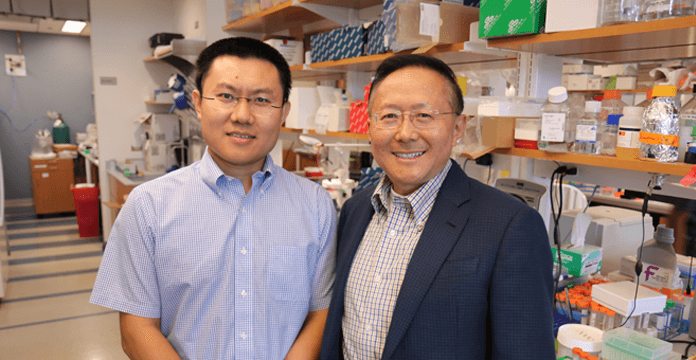New genome-editing strategy developed at UMMS may lead to therapeutics
Dan Wang, Guangping Gao and colleagues describe approach in Nature Biotechnology
Date Posted: August 13, 2018 |
|
|
Dan Wang, PhD, and Guangping Gao, PhD |
Researchers at UMass Chan Medical School have developed a genome-editing strategy to correct disease-causing DNA mutations in mouse models of human genetic diseases, according to research published in the Aug. 18 edition of Nature Biotechnology.
First author Dan Wang, PhD, instructor in microbiology & physiological systems, together with co-corresponding authors Guangping Gao, PhD, the Penelope Booth Rockwell Professor in Biomedical Research, professor of microbiology & physiological systems, director of the Horae Gene Therapy Center and co-director of the Li Weibo Institute for Rare Diseases Research; Wen Xue, PhD, assistant professor of RNA therapeutics; and Phillip Zamore, PhD, Howard Hughes Medical Institute Investigator, the Gretchen Stone Cook Chair of Biomedical Sciences and chair and professor of RNA therapeutics, said the development may lead to a therapeutic approach that could potentially be applied to a large population of patients with various genetic diseases. Dr. Wang said the first step in their research was creating mice that have two different mutant gene copies to mimic the genetic makeup of many patients.
“Patients with many genetic diseases usually carry two different mutant gene copies, one from the mother and the other from the father,” Wang said. “However, research mouse models with these diseases almost always carry the same mutation.”
Researchers delivered the genome-editing machinery, known as the Cas9/sgRNA system, into mice using recombinant adeno-associated viral vectors. The design of the genome-editing strategy promotes reshuffling of the genetic material to generate two new copies of the gene, one of which is mutation-free and confers therapeutic benefits. In many genetic diseases, the presence of one functional gene copy is sufficient to support normal cellular function, Wang said.
“We demonstrated the therapeutic efficacy of this approach in two diseases, hereditary tyrosinemia type I and a lysosomal storage disease known as Hurler syndrome,” Wang said. “This therapeutic genome-editing strategy has several advantages, including flexibility in design, compatibility with different mutations and thus likely to be applicable for more patients, and a better safety profile due to the design as it avoids introducing undesired alterations to the targeted gene product, achieving scarless gene editing.”
Wang said the hope is that the new therapeutic approach can potentially be applied to a large population of patients with various genetic diseases.